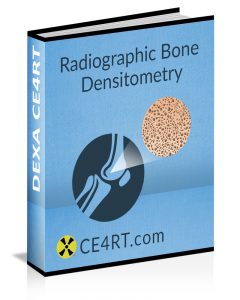DXA Technologist : Advice for Patients with Osteopenia

Radiologic technologists, especially those working as DXA operators, may often come across patients who do not qualify as osteoporotic, but still have low bone mass. Osteopenia is a term used to describe low bone mass which is lower than normal but not low enough to qualify as osteoporosis. People with osteopenia are at an increased risk of fractures. This can be likened to the classification used for “bad” cholesterol (LDL) where individuals are at high risk if the value is more than 160 mg/dL and moderate risk if the value is between 130 and 160 mg/dL. What is osteopenia treatment? And what advice should be given to patients who are osteopenic?
Osteopenia Definition
The range of BMD values that qualify as osteopenia is quite large. Individuals with T-scores of -1 to -2.5, or in other words standard deviations of 1 to 2.5 below the peak bone mass average for a healthy adult, are said to be osteopenic and may require osteopenia treatment. This is equivalent to a bone mineral density that is approximately 10-30 percent less than the average BMD for a young adult with normal bone mass. Thus, rather than truly being a disease of the bones, osteopenia is a description of bone mass. As noted, a wide range of T-scores are included in the definition. Therefore, the fracture risk of individuals with osteopenia varies greatly from person to person.
What Should I Tell a Patient with Low Bone Mass?
It should be noted that informing an individual that they have osteopenia can lead to unnecessary alarm. Healthcare providers should address bone health with patients in terms of fracture risk. The T-scores obtained on BMD measurement are one component of this risk. For example, younger people with osteopenia may actually have a relatively low fracture risk. To prevent patients from becoming excessively concerned, healthcare providers sometimes avoid using the term osteopenia and simply tell the individual that their bone mass is somewhat low, putting them at a slightly higher fracture risk. Patients must, of course, then be informed about how to address the low bone mass and minimize their risk of fracture with osteopenia treatment.
Advice for Patients with Osteopenia
It is important to advise patients that osteopenia often does not cause any symptoms. However, a person who has low bone mass must take certain steps to reduce the risk of progressing to osteoporosis. Risk factors for low bone mass include:
- Age (more common in people above 50 years old)
- Diet (low calcium and vitamin D predisposes to osteopenia)
- Smoking
- Medications that increase bone loss (for example, steroids and some anticonvulsants and cancer drugs)
- Medical conditions such as lupus, celiac disease, rheumatoid arthritis, and lactose intolerance
Diagnosis of osteopenia is made by DXA scanning performed usually at the hip or spine. The T-score, which compares bone mass to a young healthy adult, is used to classify a person’s bone density. Osteopenia treatment is recommended in people with a T-score between -0.1 and -2.5.
Osteopenia Treatment
Better nutrition with foods that improve bone health is the first step in osteopenia treatment. Calcium-rich foods include dairy products, green leafy vegetables, and certain fish like sardines. Foods with a high vitamin D content include oily and fatty fish as well as fortified cereals and milk.
The next lifestyle change that can serve as osteopenia treatment is regular exercise. A person’s physical activity regimen should include body weight exercises (squats, pushups), lifting weights, working out on weight machines, and doing cardiopulmonary activities such as walking, running, cycling, dancing, and climbing stairs. In addition, exercises that improve flexibility and balance, such as tai-chi and yoga, should be incorporated into the regimen to prevent the risk of falls.
Avoiding nicotine, reducing phosphate-containing foods and drinks such as sodas, and limiting salt intake are other preventive measures for people with low bone mass.
Osteopenia treatment does not usually include medications until the condition progresses to osteoporosis. However, a bisphosphonate medication may be prescribed if an osteopenic person has suffered a fragility fracture.
ARRT® CE Credits
Did you find this article on osteopenia treatment useful? You can learn more about bone health and bone density measurement from our series of free continuing education articles. We also have articles on radiographic positioning for X-ray techs. However, these articles will unfortunately not earn you any ARRT® CE credits. To completely your continuing education requirements, purchase one of our e-courses and post-tests. This is an easy and convenient way to complete your DXA and X-ray CE online from the comfort of your home. Our course on Bone Densitometry is worth 23 credits.
